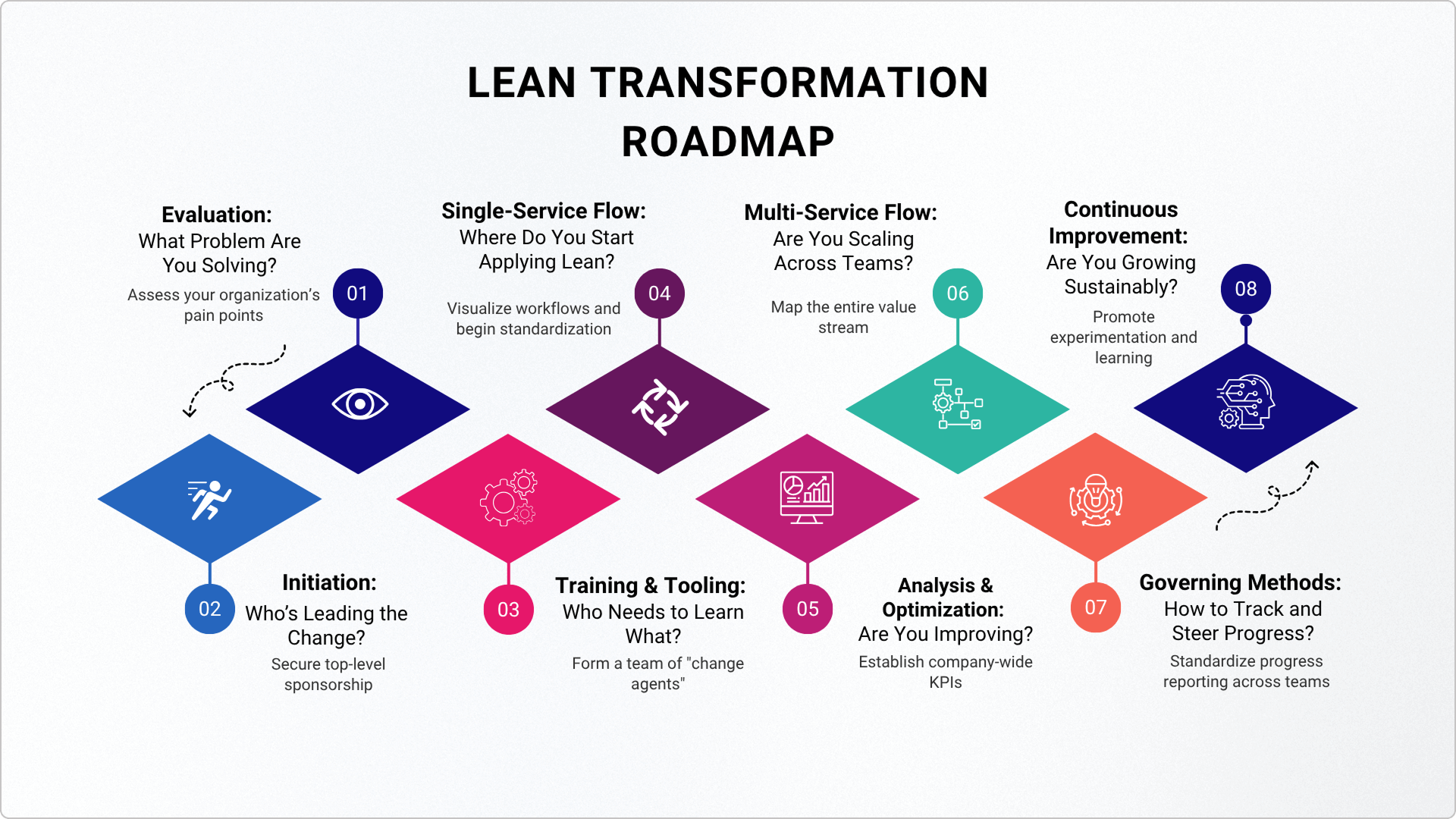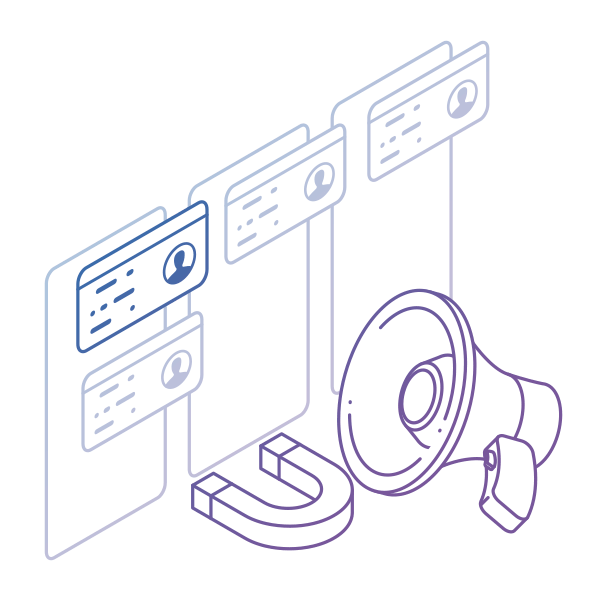Key Takeaways
-
What is a Lean transformation roadmap? A step-by-step guide to planning and executing Lean improvements.
-
Why use one? It helps teams align goals, avoid chaos, and scale improvement efforts.
-
Core phases: Evaluation, Initiation, Training, Single-Service Flow, Optimization, Scaling, Governance, and Continuous Improvement.
What Is a Lean Transformation Roadmap?
A Lean transformation roadmap is a structured guide for organizations looking to evolve their processes through Lean thinking. Instead of diving into change blindly, a roadmap provides clarity, structure, and alignment - essential in today’s fast-paced, knowledge-based work environments.
Whether you’re solving delivery delays, improving quality, or increasing customer satisfaction, this roadmap helps you plan responsibly, prioritize initiatives, and ensure everyone - from C-level executives to teams - is on the same page.
What Are the Main Phases in a Lean Transformation Roadmap?
Here’s a simplified breakdown of the 8 core phases:
1. Evaluation: What Problem Are You Solving?
- Assess your organization’s pain points.
- Decide between a "start small" or "all-in" transformation.
- Use models like the Lean Transformation Framework (LTF) to clarify direction.
2. Initiation: Who’s Leading the Change?
- Secure top-level sponsorship - ideally from a board member.
- Set transformation milestones and review cadence.
- Allocate budget for training, coaching, and tooling.
3. Training & Tooling: Who Needs to Learn What?
- Train managers first, then team leads and staff.
- Form a team of "change agents" with at least 50% of their time allocated to the initiative.
- Start experimenting with Lean tools (e.g., Root Cause Analysis, Kanban, PDCA).
4. Single-Service Flow: Where Do You Start Applying Lean?
- Map out services (like Marketing, DevOps, Support).
- Visualize workflows and begin standardization.
- Implement visual work boards to make work transparent.
5. Analysis & Optimization: Are You Improving?
- Establish company-wide KPIs (cycle time, throughput, WIP).
- Eliminate reliance on subjective metrics, such as story points.
- Use historical data to forecast work and measure performance.
6. Multi-Service Flow: Are You Scaling Across Teams?
- Extend Lean practices upstream (in Product Management) and downstream (in Documentation).
- Map the entire value stream.
- Apply Theory of Constraints (ToC) to identify bottlenecks.
7. Governing Methods: How to Track and Steer Progress?
- Introduce a Portfolio Kanban system to visualize big-picture work.
- Standardize progress reporting across teams.
- Use cadences and feedback loops to manage flow.
8. Continuous Improvement: Are You Growing Sustainably?
- Embrace the PDCA (Plan–Do–Check–Act) cycle.
- Reinforce Lean leadership and cultural alignment.
- Promote experimentation and learning as a long-term strategy.

Lean Roadmap’s Use in Different Sectors
Lean isn’t just for manufacturing anymore. With visual workflow systems and agile tooling, it fits:
-
Logistics: Streamline complex purchasing processes.
-
Software & IT: Improve delivery pipelines and product quality.
-
Telecommunications: Workflow standardization across teams.
-
Healthcare: Streamline patient services and admin processes.
-
Marketing: Prioritize campaigns and remove handoff delays.
-
Legal/Support: Increase transparency and reduce backlog cycles.
Lean Roadmap Template Essentials
If you’re building your Lean roadmap, here are the must-have components:
| Component |
Purpose |
|
Vision & Goals
|
Define what success looks like and why it matters. |
| Current State Assessment |
Understand your workflows and challenges. |
| Lean Tools & Metrics |
Choose tools like visual boards; track cycle time, WIP. |
| Transformation Phases |
Plan out your 8-step roadmap. |
| Leadership Roles |
Identify sponsors, coaches, and change agents. |
| Communication Plan |
Align stakeholders, report status transparently. |
| Feedback Loops |
Schedule regular reviews to course-correct. |
How to Create and Tailor a Lean Roadmap for Your Organization
-
Start from where you are: Don’t wait for perfection - map your current processes.
-
Define clear goals: Choose a small number of high-priority problems.
-
Pick the right tools: Start with Kanban or A3 problem-solving for visual planning and tracking.
-
Train in layers: Educate senior leaders first, then build internal capability.
-
Scale mindfully: Focus on value streams, not just team-level improvements.
Where Can You Find Lean Roadmap Templates?
To create a transformation roadmap - especially for Lean transformation or similar strategic change initiatives - organizations typically use a combination of digital tools, templates, and specialized software solutions:
-
Digital Roadmaps and Visual Boards: Kanban boards are used to visualize phases, activities, and progress of Lean transformation for both small teams and enterprise-wide rollouts.
-
Visual Planning Tools: Gantt charts enable the planning and visualization of roadmap phases, dependencies, and due dates.
-
Roadmap Templates and Online Creators: Typically include customizable fields for milestones, activities, owners, timelines, and KPIs, which are helpful for quickly mapping out your transformation.
-
Value Stream Mapping Tools: Specialized value management software or templates that help teams visualize and optimize process flows.
-
Process Mapping and Root Cause Analysis Tools: Used to detail current/future states and identify key improvement areas.
-
Lean-Specific Software Solutions: Tools like Businessmap offer features tailored for Lean-operating organizations, including Kanban workflows, analytics, and performance tracking.
Businessmap is the most flexible software
to align work with company goals








